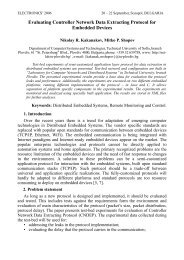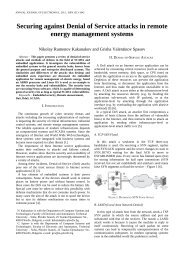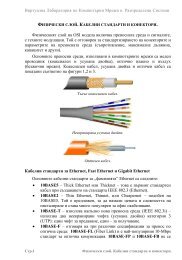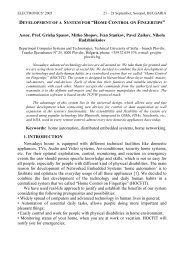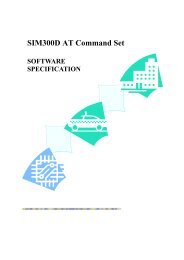CGI-based applications for distributed embedded systems for ...
CGI-based applications for distributed embedded systems for ...
CGI-based applications for distributed embedded systems for ...
You also want an ePaper? Increase the reach of your titles
YUMPU automatically turns print PDFs into web optimized ePapers that Google loves.
International Conference on Computer Systems and Technologies - CompSysTech’2004<br />
Internet<br />
SERVER OS<br />
Web:<br />
IIS Windows<br />
Apacha Linux/Unix<br />
JWS SUN<br />
Client<br />
Browser:<br />
IE<br />
Netscape<br />
Opera<br />
http/html<br />
Dinamic<br />
Pages<br />
ASP (IIS)<br />
<strong>CGI</strong> (Apacha)<br />
Java (JWS)<br />
Data<br />
from<br />
Sensor<br />
Figure 3. Three-layer model <strong>for</strong> client-server <strong>applications</strong>.<br />
In most of the cases, especially in the data processing <strong>systems</strong>, the three layer<br />
model is used.<br />
The first layer is the client that functions by the well-known browsers – Internet<br />
explorer, Netscape, Opera, etc.<br />
The second layer is the Web server that works with dynamic HTML pages – IIS<br />
(Windows), Apache (Unix/Linux), JWS (SUN).<br />
The third layer is a database system, or in <strong>embedded</strong> <strong>systems</strong> – a module that<br />
realizes the automation and/or control of a device.<br />
The main advantage of this model is the dynamic generation of the in<strong>for</strong>mation. On<br />
the client’s request, the Web server starts a process that generates dynamically HTML<br />
page, <strong>based</strong> on the data from the third layer.<br />
IPC@CHIP<br />
RTOS<br />
<strong>CGI</strong><br />
Web<br />
Server<br />
Client<br />
browser<br />
User<br />
Applications<br />
Running on<br />
server<br />
SMS<br />
Sender<br />
Temperature<br />
& Humidity<br />
Sensing<br />
Figure 4. Functional blocks and relations<br />
Figure 4 shows the three layer model in the <strong>distributed</strong> system <strong>for</strong> monitoring of<br />
temperature and humidity, <strong>based</strong> on IPC@Chip [5].<br />
The functions of the system are separated between the four main blocks which<br />
corresponds with the three-layer on the following way:<br />
− The internet browser assures that the system has a familiar user interface. The<br />
visualization of the monitored parameters is placed here.<br />
− The integrated Web server in conjunction with the <strong>CGI</strong> deals with the control of<br />
the remote processes and transfer of dynamic HTML pages to the client. The realtime<br />
operating system (RTOS) of the IPC@Chip manages with the Web server’s<br />
- I.6-3 -



